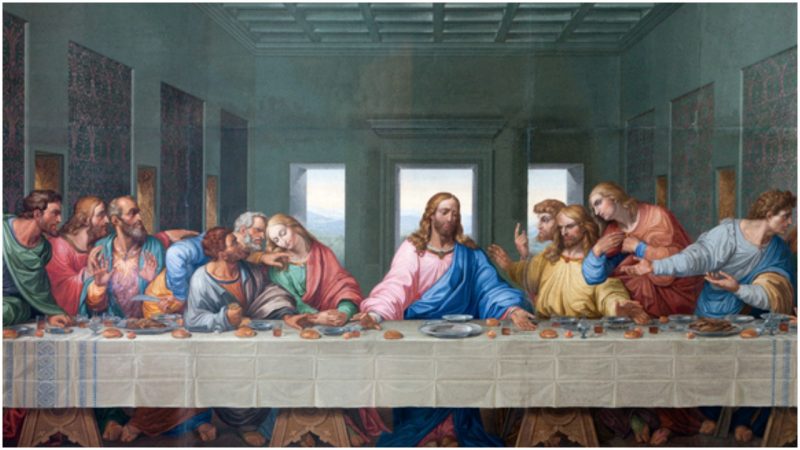Some of the most epic works of art produced by Renaissance artists were inspired by episodes and characters from the Bible.
Although many of these artistic renderings remain true to what is written in the Bible, claims have been made about all sorts of hidden messages in various paintings.
There is a brain in ‘The Creation of Adam’
One of the most iconic works of Michelangelo is ‘The Creation of Adam,’ one the panel images featured on the Sistine Chapel’s ceiling.
The great Florentine artist spent four years working on the Vatican chapel’s ceiling, adding the final touches in early November 1512.
That would have been enough time to think of what other images he could embed in the paintings there.
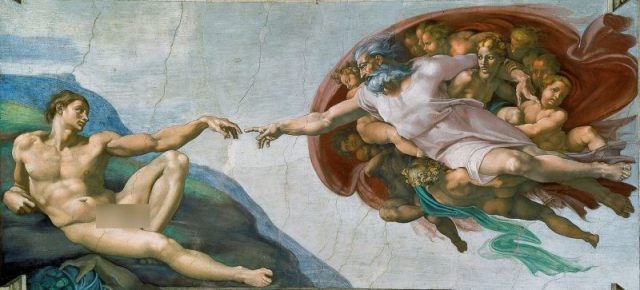
It is traditionally thought that his Creation of Adam recalls the Biblical episode in which God breathes life into Adam. But a human brain cleverly hidden in the picture adds an extra dimension to interpretations of his work.
The brain is concealed in the image of God and went unnoticed until 1990 when American physician Frank Meshberger described his realization in the Journal of the American Medical Association. He saw a splendid illustration of the brain’s anatomy.
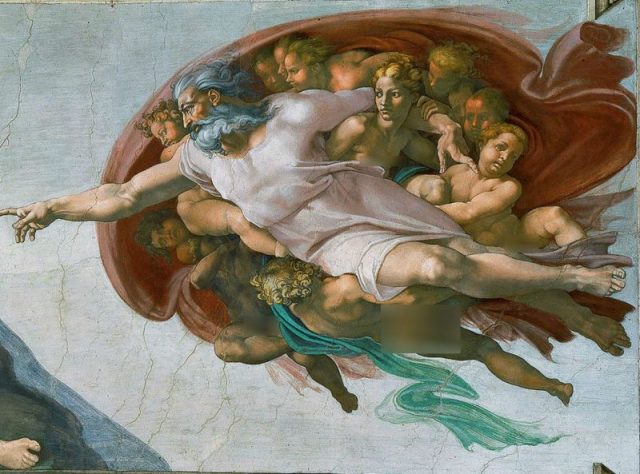
On closer inspection, the Sylvian fissure that separates the brain’s frontal lobe from both the parietal and temporal lobes can be recognized. “It is represented by a bunching up of the cape by one of the angels and by a fold in God’s tunic,” writes Psychology Today.
Different areas of the brain are represented by those otherworldly, divine figures surrounding God, altogether composing an entirely brain-looking realm of the panel picture indeed.
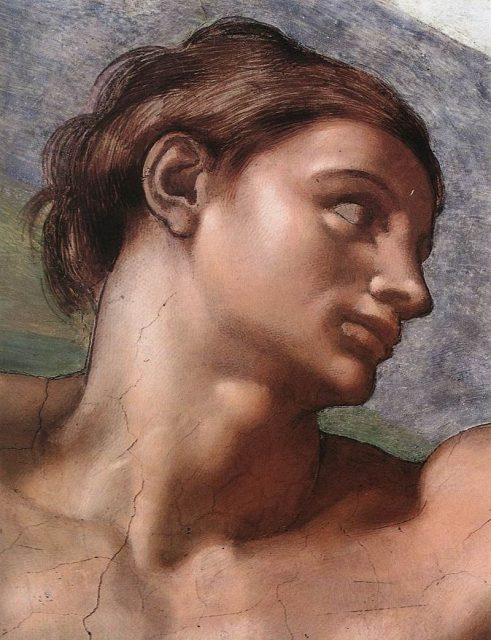
More difficult to answer is whether Michelangelo truly knew the human brain in such great detail. He may have worked on real human corpses to explore anatomy, but did he really get the chance to ponder on the brain constituents such as the cerebellum or the pituitary gland?
A thorough knowledge of the brain areas was not commonly known to scientists until bit later than the Renaissance. If Michelangelo truly had an accurate understanding of the brain’s composition, he accurately showed it off with the language of art.
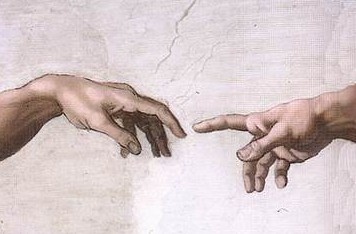
Or maybe the similarities between features in The Creation of Adam and pictures in a modern anatomical textbook are entirely a work of chance.
One may keep wondering: is the artist perhaps hinting that God is merely an invention of the human mind?
There is more than one brain in the Sistine Chapel
Among the last pieces which Michelangelo did for the Sistine Chapel project was his take on ‘God Dividing Light from Darkness.’
Michelangelo normally portrayed bodies to perfection, however, in this panel God appears to wear an anatomical anomaly around his neck.
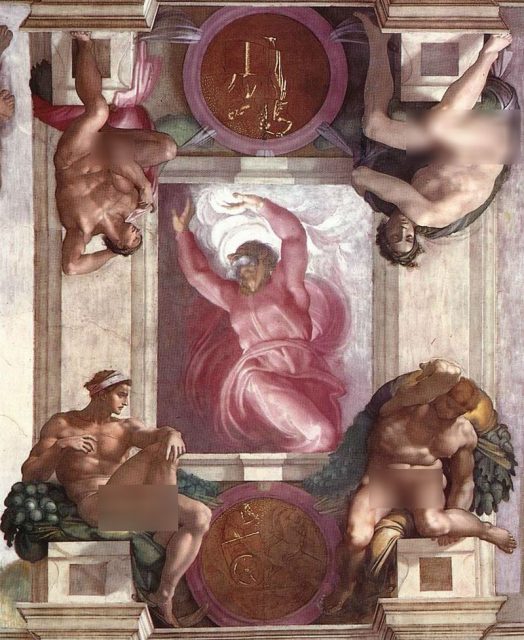
It has been proposed that Michelangelo added a concealed image of a brain stem, with both eyes and the optic nerve.
The detail can be spotted by superimposing the original Michelangelo with an image of the human brain photographed from below.
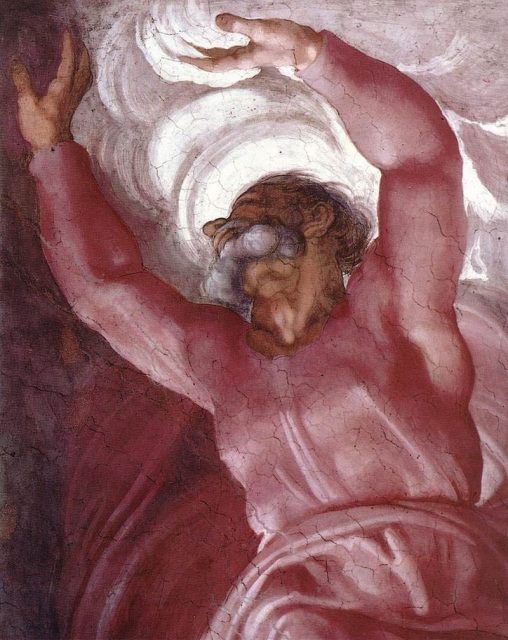
The idea is that the two images show how Michelangelo’s anatomical oddity on God looks the same as the image of the brain.
The robe that God is wearing is also found to have a strange roll that could further represent the human spinal cord, according to Scientific American.
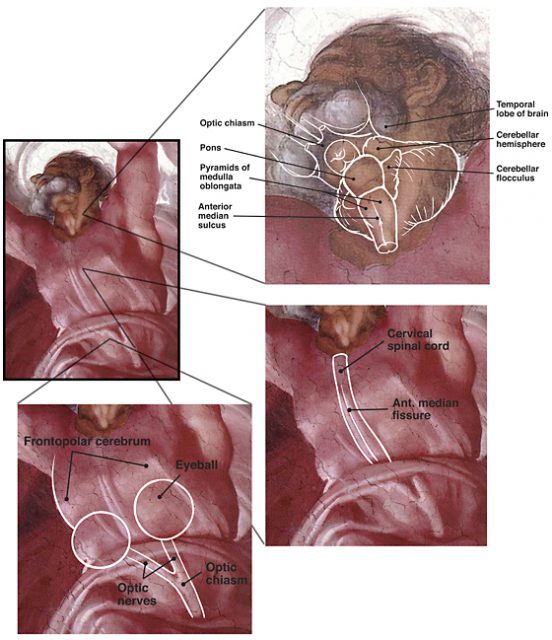
So, what could possibly be the hidden message here, if Michelangelo ever intended one? Perhaps ‘God Dividing Light from Darkness’ was the artist’s response to the ongoing friction between religion and science that was omnipresent at the time.
Flying saucers on 15th-century paintings?
Another painting, called ‘Madonna with Saint Giovannino’ and attributed to another Florentine, Domenico Ghirlandaio, might reveal nothing unusual at first sight.
But a closer look at the painting reveals a large speck looming in the sky, to the left of the image’s central figure.
The painting, which was produced in between 1449 and 1494, today is said to lure crowds to the Palazzo Vecchio in Florence, precisely to see this weird speck.
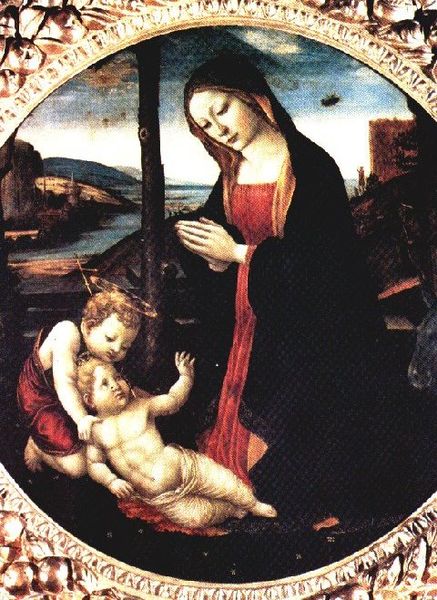
For conspiracy theorists, it’s more than a speck. It reminds them of a flying saucer. And there is more: a man in the background seems to be observing the mysterious-looking object that emits radiant rays of light. A dog next to him is apparently hostile to the intruder.

The Madonna’s posture is also “purposefully” turning her back to the hovering object, shielding the children from any harm that might come from it.
Her halo also seems somewhat obscured, possibly by the UFO.
However, the UFO speck may be dismissed as just another stellar object. The Nativity star shines brightly just on the left upper corner of this beautiful painting.
Hidden images and harmonious music in ‘The Last Supper’
The halo used to designate the status of someone as sacred proves to be problematic in other Renaissance paintings.
In fact, in Da Vinci’s ‘Last Supper,’ which depicts Jesus having his last meal in the company of the 12 Apostles and just before he is betrayed, there is a total absence of halos.
In earlier renderings of this scene from before the 15th century, the halo is present almost everywhere. Da Vinci sort of downplayed the convention of how the Biblical characters should be represented. Perhaps he wanted to show all of them, Jesus included, as mere mortals.
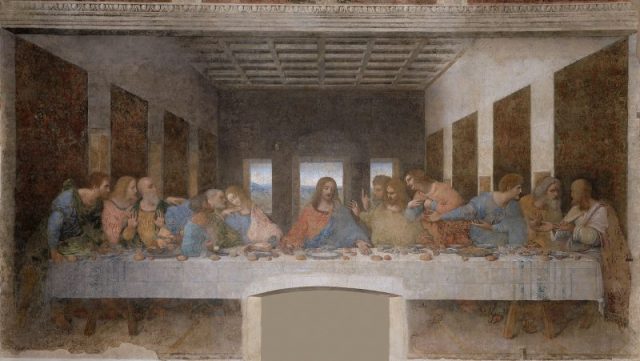
But the halo question is not the most intriguing one that revolves around this mural painting that was produced from 1494 to 1494 in Milan’s Church of Santa Maria Delle Grazie.
A more interesting claim is that the painting features a hidden image of a woman holding a child. The Dan-Brown-oriented suggestion was made in 2007 by Italian scholar Slavisa Pesci.
The hidden figures show up only when Da Vinci’s painting is superimposed with its mirror image. The two images need to be further adjusted for their translucency so that the figures appear before the spectator.
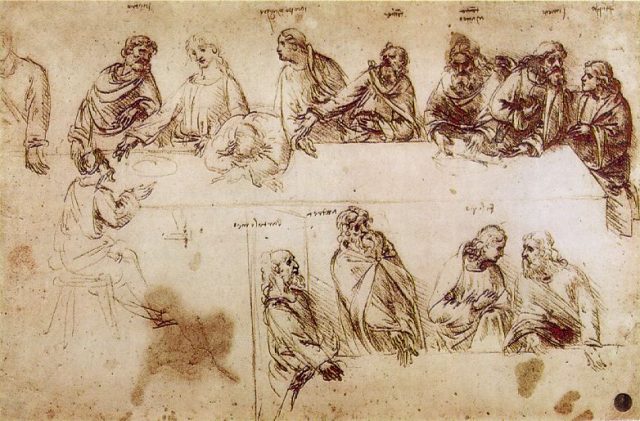
Many were fast to assert the figure was that of Mary Magdalene, but more acclaimed critics received the news with reserve as they deemed the double-image too blurry to be conclusive.
Besides the woman, a goblet also emerges with the help of the mirror image. It appears in front of the portrayal of Jesus and might stand for the blessing of the bread and wine that is laid for the supper. Two of the disciples at the table transform simultaneously into knights.
![Detail of the “beloved disciple” to Jesus’s right, identified by art historians as the apostle John,[25][26] but speculated in The Da Vinci Code and similar works to actually be Mary Magdalene in disguise](https://www.thevintagenews.com/wp-content/uploads/sites/65/2018/10/juan_en_la_ultima_cena_de_leonardo_da_vinci-640x536.jpg)
Pala has said the composition “sounds like a requiem,” and that it is “like a soundtrack that emphasized the passion of Jesus,” according to Live Science.
Musicians are instructed to read the hidden musical signs from right to left and use a pipe organ if they want to hear the best results.
Mona Lisa’s eyes are full of letters and numbers
Debates regarding the Mona Lisa demonstrate that secretive codes are not limited only to paintings that feature Biblical figures.
The most famous of Leonardo Da Vinci’s works has been closely examined for cryptic messages left there on purpose.
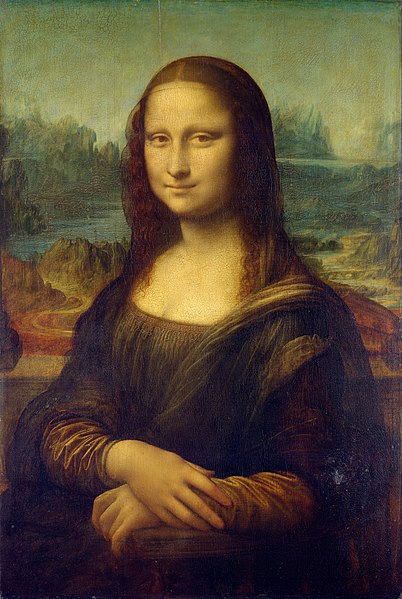
In 2010, Italian researcher Silvano Vinceti reported that he saw more than an enigmatic smile when he zoomed in on hi-resolution photographs of the Mona Lisa.
Alphabetical symbols and numbers, specifically the letters LV, appear to be embedded in the woman’s right eye, perhaps the initials of Da Vinci’s own name. The symbols contained in the left eye were allegedly more difficult to pin down, but Vinceti spotted either the letters CE or just the letter B.
Scrutinizing the background, he found more numbers and letters. These include the number 72, or alternatively L2, and on the back of the painting, the number 149_, with a blurred fourth symbol. One explanation for 149 is that Da Vinci worked on this portrait in Milan during the 1490s, albeit it’s generally agreed the portrait was created between 1503 and 1506.
Not everyone is enthusiastic about Vinceti’s efforts, who also wants to exhume the remains of the great painter from his grave in in Amboise, France.
Read another story from us: Portrait of the Devil? Hidden Image in Vosper’s Famous Painting “Salem”
“The ‘discovery’ of initials in Mona Lisa’s eyes” is just a “crackpot idea,” Stephen Bayley writes in the Telegraph. He also refers to Vinceti as “a rather sensationalist television presenter.”
